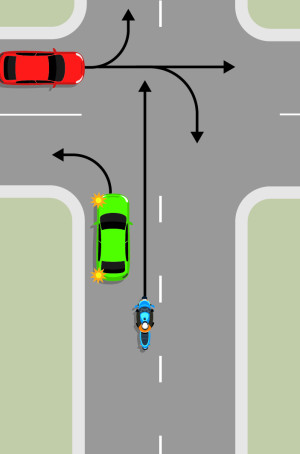Many serious crashes on our roads are caused by dangerous passing.
To safely pass another vehicle, you need to be extremely careful. You must have a clear view of the road ahead, to make sure you can finish passing safely. You must also pay close attention to the vehicle you are passing, in case it changes its course.
Passing on the right can be dangerous, especially if you have to:
Before passing, always ask yourself, ‘do I really need to pass?’ Don’t pass just because you're feeling impatient with the vehicle in front – that’s often when crashes happen.
If you decide to pass, follow these rules.
Before you pass:
Before pulling in front of a vehicle you've passed:
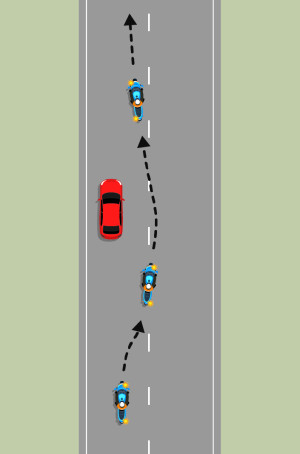
Passing on the right
You can only pass on the left when:
Be careful when passing a vehicle signalling a right turn, as other drivers may not see you.
At all other times, when you're passing, you must pass on the right.
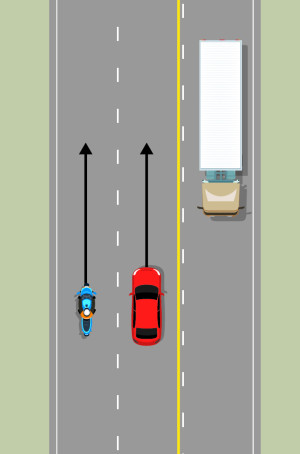
Passing on the left
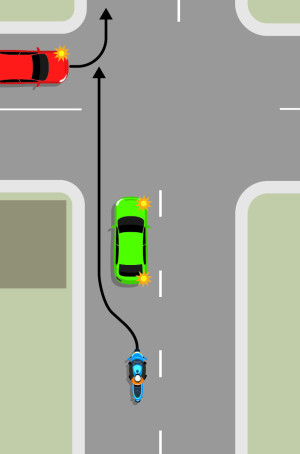
Going around a vehicle
ImportantWhen riding in a group, don’t get stranded on the wrong side of the road when passing. Make sure you have 100 metres of clear road ahead of you at all times. |
On some sections of road there'll be a solid yellow line painted on your side of the centre line. This line is called a no-passing line.
No-passing lines are usually there because it’s unsafe to cross the centre line to pass, because features like hills and curves make it impossible to see if there's oncoming traffic.
Sometimes no-passing lines are marked because:
You must not pass any vehicle if it means you have to cross over a no-passing line on your side of the centre line.
If you see a broken yellow line on your side of the centre line, that means that a no-passing line is about to start. While you may come back over the broken yellow line to finish passing, you must not cross it to start passing.
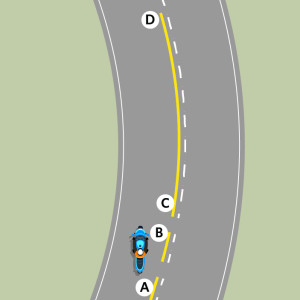
No-passing line
As shown in the picture above:
You can pass at a no-passing line if:
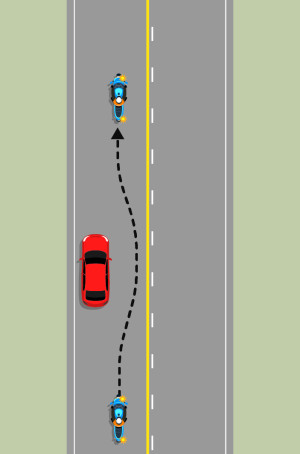
Passing without crossing the no-passing line
If there's no solid yellow line on your side of the centre line, you may use the centre lane to pass as long as:
Don’t use the centre lane to pass if there's an oncoming vehicle in the centre lane.
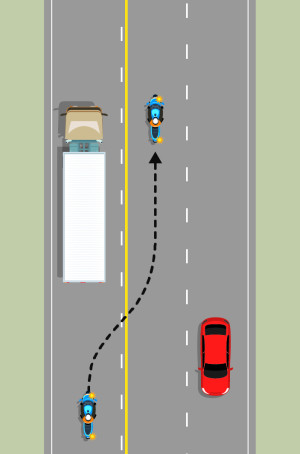
Passing on a 3-laned road
ImportantKeep a safe distance behind the vehicle you’re about to pass. Follow the 2-second rule. If you’re being passed by another vehicle:
|
You should allow at least 1.5 metres between you and a person riding a bicycle when passing. If you can’t pass safely, slow down and wait behind the cyclist until you can.
Sometimes a cyclist may want to move to the centre of the lane to keep safe. This is called taking the lane. You can use a flush median to pass a cyclist as long as you can do it safely.
Situations when cyclists may take the lane are:
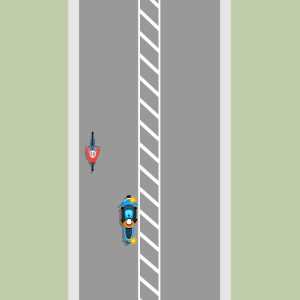
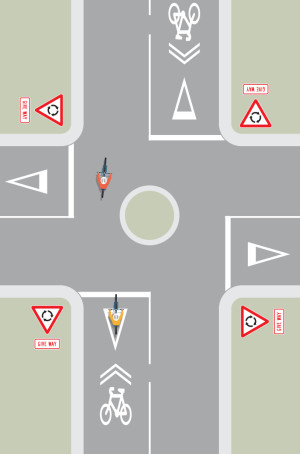
You may see a sharrow marking in these situations.
The sharrow road marking shows where cyclists are likely to ride in the centre of the lane for safety. You should slow down and follow the cyclist until the road widens and you can pass safely, or use another lane to pass them.

Remember, it's against the law to cross over a no-passing line on your side of the centre line to pass another vehicle. But this isn’t the only situation where you mustn’t pass. There are other situations where passing is both unsafe and illegal.
Don’t pass any vehicle that's stopped, or is slowing down, for people on a pedestrian crossing.
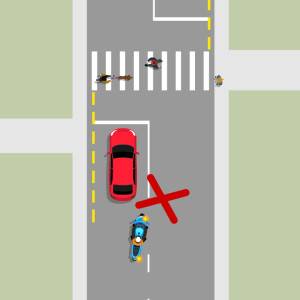
Illegal passing near a pedestrian crossing
Don’t pass any vehicle when you're coming to a blind corner or curve. A blind corner or curve is where you can’t see what’s around the corner.
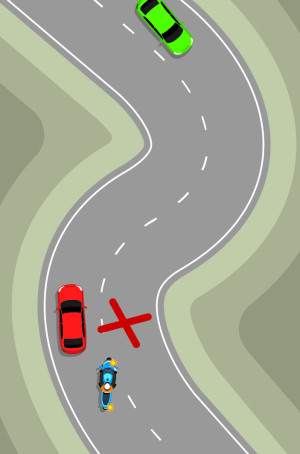
Illegal passing on a curve
Don’t pass any vehicle when you can’t see at least 100 metres of clear road in front of you for the whole time while you're passing.
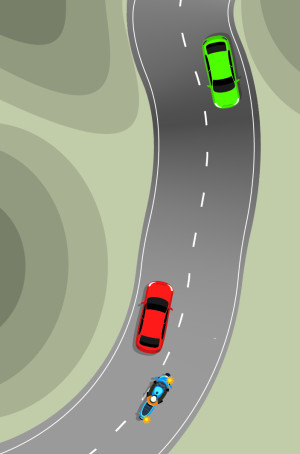
Illegal passing without 100 metres of clear road
When approaching or crossing an intersection, don’t pass on the right of a vehicle if it means you’ll cross the centre line. You must not get in the way of:
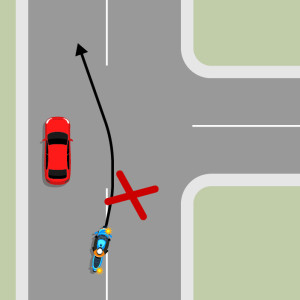
Illegal passing at an intersection
Don’t pass:
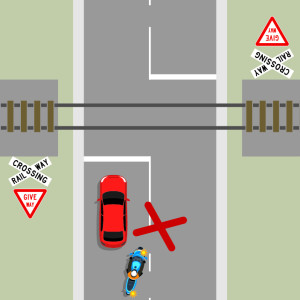
Illegal passing near a railway level crossing
Don’t pass any vehicle if it means you have to ride over a flush median
Information about flush medians
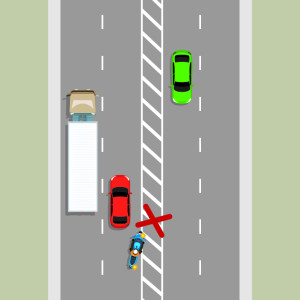
Illegal passing on flush median
In some situations, you're allowed to pass another vehicle at an intersection. However, you need to be very careful when doing this.
In this situation, you can pass on the left if there's enough room in your lane for you to pass and the vehicle you're passing:
Don’t pass if the vehicle has signalled a left turn.
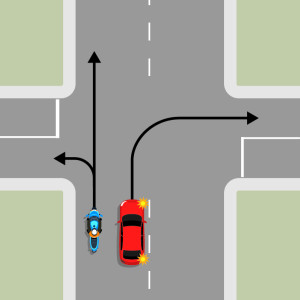
In this situation, you can pass on the left if the vehicle you're passing is in a different lane and you can pass safely.
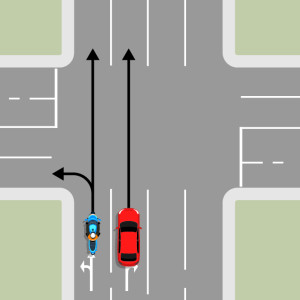
In this situation, you can pass on the right if you're turning right or going straight ahead.
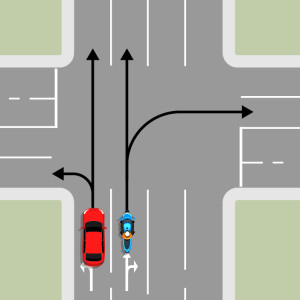
Be careful in this situation as a driver turning out of an intersection may not know you’re there because the vehicle turning left is blocking their view.
